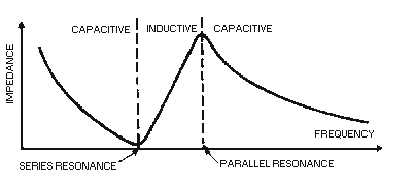2-26
Figure 2-21.—Frequency response of a crystal.
Since the series-tuned circuit acts as an inductor above the resonant point, the crystal unit becomes
equivalent to an inductor and is parallel with the equivalent capacitor C1 (view (B) of figure 2-20). At
some frequency above the series-resonant point, the crystal unit will act as a parallel-tuned circuit. A
parallel-tuned circuit has a MAXIMUM impedance at the parallel-resonant frequency and acts inductively
below parallel resonance (figure 2-21). Therefore, at some frequency, depending upon the cut of the
crystal, the crystal unit will act as a parallel-tuned circuit.
The frequency stability of crystal-controlled oscillators depends on the Q of the crystal. The Q of a
crystal is very high. It may be more than 100 times greater than that obtained with an equivalent electrical
circuit. The Q of the crystal is determined by the cut, the type of holder, and the accuracy of grinding.
Commercially produced crystals range in Q from 5,000 to 30,000 while some laboratory experiment
crystals range in Q up to 400,000.
Crystal-Controlled Armstrong Oscillator
The crystal-controlled Armstrong oscillator (figure 2-22) uses the series-tuned mode of operation. It
works much the same as the Hartley oscillator except that frequency stability is improved by the crystal
(in the feedback path). To operate the oscillator at different frequencies, you simply change crystals (each
crystal operates at a different frequency).
Figure 2-22.—Crystal-controlled Armstrong oscillator.
Variable capacitor C1 makes the circuit tunable to the selected crystal frequency. C1 is capable of
tuning to a wide band of selected crystal frequencies. Regenerative feedback from the collector to base is



